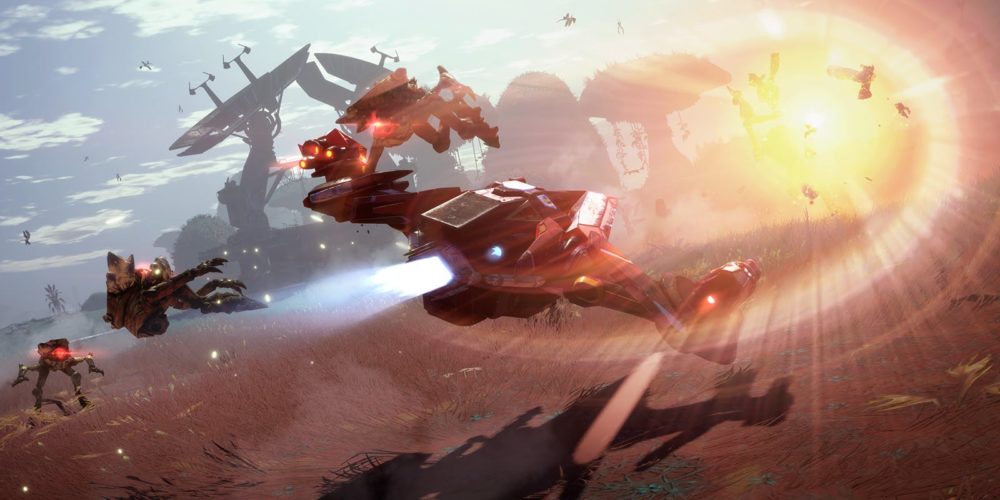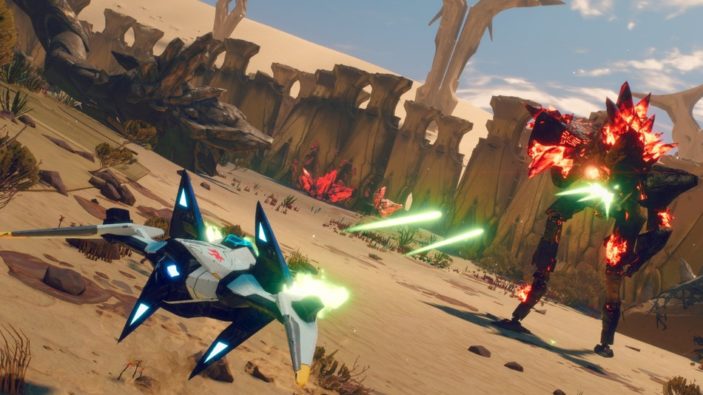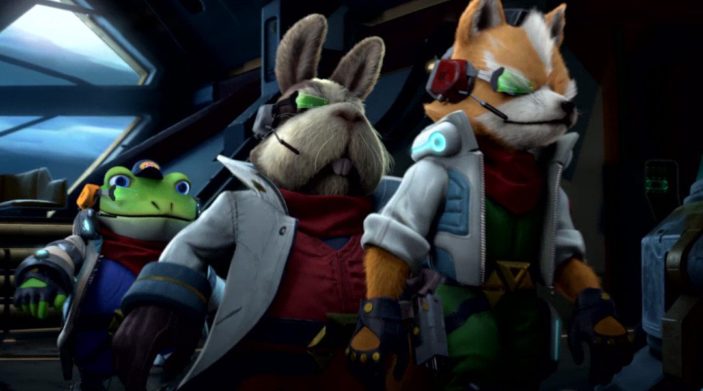
Thought that ‘toys to life’ video game fad was over? That the days of collecting Skylanders and Disney Infinity figures were behind you? Guess again. Starlink: Battle for Atlas marks developer Ubisoft Toronto’s first attempt at creating a fun, friendly, accessible spaceship combat-based experience for the young and old alike. While it’s not perfect, Starlink: Battle for Atlas surprisingly does a lot right, with its charming visuals, a dense open world and deep sense of customisation and variety. And oh yeah, I forgot to mention, the Nintendo Switch version brings the StarFox gang back yet again to join the Starlink crew for the entire ride.
While Starlink: Battle for Atlas puts players in the shoes of various pilots and in command of many starships, it mostly centres around the Starlink initiative, a group of explorers on a mission to discover the origins of an amnesiac alien who crash landed on Earth. While that’s the plot in a nutshell, the story offers a few neat twists and turns with an added sense of variety thanks to an even blend exploration and combat. Voice performances weren’t astounding, but passable across the board, as a few emotional moments hit their mark. What I found most interesting about Starlink was its tone. For what I initially thought was a game marketed at children due to its ‘toys to life’ approach, became a game I wished No Man’s Sky was upon its release. Cartoonish graphics aside, Starlink takes players seriously, offering them a sense of choice in the way the progress, where handholding is somewhat dormant, especially in the latter half of the experience. I feel like this game was made for the kids who grew up with Skylanders but left it behind wanting something just as fun and creative, but slightly more mature.

Combat in Starlink is fluid and functional, thanks to its simplistic controls that are easy to learn, but not quite as easy to master. Much like many other space-combat or aerial combat-based games, you’ll be strafing, boosting and navigating large open spaces with a combination of attacks to dish out to your enemies using a two weapon system. The main draw here is the instant sense of customisation as you attach weapons to your current ship which change on the fly. Attaching physical weapons to your ship is as simple as it is instantaneous, although it can get a little tedious after cycling few a through weapons, so I simply found myself sticking with around three weapons and only changing to counter an enemy weakness. Some light RPG mechanics allow for upgradeable weapons depending on how much you use them, and can be augmented with mods you can collect. In saying this, I found myself absolutely demolishing my enemies by the end of the game thanks to sticking with only a handful of weapons. Combat is also separated into space and land segments. In the openness of space, you’ll find yourself darting about at high speeds and attempting various manoeuvres, while land combat is based more around strafing as the pace is significantly slower. It’s not a bad thing however, as the gunplay keeps things tense, but there is a noticeable shift in the pace of combat here. However, I found the dual weapon system keeping things fresh and fun, while the progression felt equally satisfying.
With only a few main story missions, the game opens up towards the end, giving you more choice about how to approach both the enemies and mission order. I appreciated this the most as it let me sink my teeth into the experience in such a way that I could sink my teeth into the open world and take my time with progression and customisation before attempting each mission. The variety hits its peak here, with a huge seamless open world to explore, full of colour, secrets and overall freedom. Ubisoft’s footprints are slightly visible here with outposts to take over and claim, but this never felt repetitive to the point where I was fed up. While the Switch version offers a touch more in its starter pack thanks to the Starfox additions, I found the graphics lacking to the point where it became a little jarring. Sure, the Nintendo Switch is no graphical powerhouse, but when entire asteroid belts and mountains magically appear in front of you, it can get old pretty fast. It’s a shame because the open world does such a great job a differentiating its planets from overall colour, to foliage, to enemy types, that the dip in graphics slightly distract from the beauty of it all.
Being a toys to life game, I’m happy to say the functionality is quite interesting, and the models themselves are actually decent looking to the point where I keep a couple ships on my bedside tables simply because they look cool. In this respect, it’s nice to see Ubisoft putting the effort in. The adaptor provided with the starter pack allows pilots and ships to be placed in its centre, with pilots going in first and ships going on top. Each wing then has its own slot for weapons. While the game conveniently pauses when switching pieces on the fly, I found the physical aspect of the experience wore its welcome sooner than I would like to admit. When aiming for portability, an integral part of the Nintendo Switch’s functionality, the lugging around of various toys becomes tiresome. Thankfully, ships, weapons and pilots can be used digitally as they are included in the starter pack, so I found myself ditching the ships half the time to compensate for the portability. However, I must include that this may not be as much of a problem on other platforms. Overall, switching parts on the fly is fun to see but does’t really add nor take away from the experience as much as I thought it would.
Fox McCloud and the gang also make their long awaited return to the gaming landscape after their Wii U adventure received lukewarm reviews. However, I am glad to say that this is truly a legitimate Starfox experience, and one of my favourite additions to the title. As the the game is fully playable with McCloud and the crew by his side, players can also partake in a small campaign centred around the infamous antagonist Wolf O’Donnell. It’s honestly a ton of fun and feels authentic within the larger Starlink universe. It seems like a genius move from the get go, but with Starfox along for the entire ride outside of his own personal campaign, you can almost consider this a loose Starfox sequel. With his signature ship included in the starter pack for the Switch, I feel as is Ubisoft made the right choice including such a famous character in a way that feels seamless and natural.

Overall, Starlink: Battle for Atlas is an admittedly fun entry into the toys to life world, thanks to some solid mechanics, colourful open world and tons of customisation. Starfox is a genius inclusion which feels like it has been taken seriously this time around, as hope for the franchise may have just been revived. The toys function well enough, as it’s honestly satisfying to see your adjustments instantly translate to the game, although it wears its bulky welcome a little too soon. It hits an intriguing middle ground as a title deep enough for adults yet accessible enough for children which I wish we could see more of in today’s market. Gather the family, you’ve just been invited to partake in the Starlink Initiative; and the Battle for Atlas has only just begun.
THREE AND A HALF STARS (OUT OF FIVE)
Highlights: Solid combat mechanics, dense open world and instantly gratifying customisation.
Lowlights: Toys-to-life aspect a little too bulky and overpowering, a few graphical hiccups along the way.
Developer: Ubisoft Toronto
Publisher: Ubisoft
Platforms: PlayStation 4, Xbox One, Nintendo Switch
Available: Now
Review conducted on Nintendo Switch with a retail code provided by the publisher.
